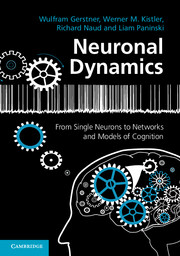Book contents
- Frontmatter
- Contents
- Preface
- PART ONE FOUNDATIONS OF NEURONAL DYNAMICS
- PART TWO GENERALIZED INTEGRATE-AND-FIRE NEURONS
- PART THREE NETWORKS OF NEURONS AND POPULATION ACTIVITY
- 12 Neuronal populations
- 13 Continuity equation and the Fokker–Planck approach
- 14 Quasi-renewal theory and the integral-equation approach
- 15 Fast transients and rate models
- PART FOUR DYNAMICS OF COGNITION
- References
- Index
12 - Neuronal populations
Published online by Cambridge University Press: 05 August 2014
- Frontmatter
- Contents
- Preface
- PART ONE FOUNDATIONS OF NEURONAL DYNAMICS
- PART TWO GENERALIZED INTEGRATE-AND-FIRE NEURONS
- PART THREE NETWORKS OF NEURONS AND POPULATION ACTIVITY
- 12 Neuronal populations
- 13 Continuity equation and the Fokker–Planck approach
- 14 Quasi-renewal theory and the integral-equation approach
- 15 Fast transients and rate models
- PART FOUR DYNAMICS OF COGNITION
- References
- Index
Summary
The brain contains millions of neurons which are organized in different brain areas, within a brain area organized in different subregions, inside each small region into different layers, inside each layer into various cell types. The first two parts of this book focused on the mathematical description of an isolated neuron. Starting with this chapter, we shift our attention to the collective properties of groups of neurons, which we call “neuronal populations.” Instead of modeling the spike times of a single neuron which belongs, for example, to the cell class “pyramidal” in layer 5 of subregion C4 in brain region S1 (the numbers here are completely arbitrary), we can ask the question: Suppose a human subject or animal receives a visual, auditory, or somatosensory stimulus – what is the activity of all the cells in this layer of this subregion that are of type “pyramidal” in response to the stimulus? What is the response of this subregion as a whole? What is the response of a brain area? In other words, at any of the scales of spatial resolution (Fig. 12.1), we may be interested in the response of the neuronal population as a whole, rather than in the spikes of individual neurons.
- Type
- Chapter
- Information
- Neuronal DynamicsFrom Single Neurons to Networks and Models of Cognition, pp. 291 - 324Publisher: Cambridge University PressPrint publication year: 2014
- 4
- Cited by



